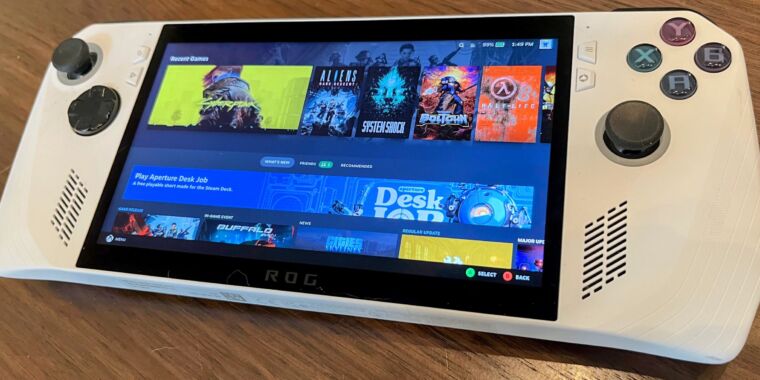Kevin Purdy
In our review of the Asus ROG Ally last year, many of our complaints centered on having to fiddle with an “awkwardly scaled” version of Windows. That’s especially true when you compare the ROG Ally experience to Valve’s Steam Deck and its finely handheld-tuned SteamOS 3.
Those ROG Ally complaints may be moot in the future, though, as Valve has confirmed that it is working to officially support SteamOS 3 installations on Asus’ handheld.
The first hint of the move came when support for “extra ROG Ally keys” popped up out of nowhere in the latest SteamOS release notes last week. Now, speaking to The Verge, Valve’s Lawrence Yang confirms that the note is indeed “related to third-party device support for SteamOS. The team is continuing to work on adding support for additional handhelds on SteamOS.”
On the other side of the portable OS equation, Yang also said Valve is continuing to work on the drivers necessary for official “dual boot” support for Windows on the Steam Deck hardware. “There’s no update on the timing for dual boot support—it’s still a priority, but we haven’t been able to get to it just yet,” Yang said.
Valve time
This is far from the first time Valve has spoken about officially distributing the latest version of SteamOS beyond the Steam Deck. Yang said in 2022 that “not only are we excited to see other manufacturers making their own handheld PC gaming devices, we’re excited to see people make their own SteamOS machines, which could include small PCs that they put next to their TV.”
Still, Valve’s confirmation of specific work on ROG Ally support is the strongest sign yet that the company is making concrete progress in this effort. Don’t get too excited about an imminent release, though—Yang told The Verge that the team is “making steady progress,” but the software “isn’t ready to run out of the box yet.” The same goes for a generic SteamOS installer that users could download and install on any generic device.
Ayaneo
In the meantime, hackers and hardware manufacturers are finding their own ways to get access to SteamOS without a Steam Deck. Ars’ Kevin Purdy ran through a cumbersome process with some very non-drop-in ISOs to get SteamOS on his ROG Ally over a year ago. And earlier this year, Ayaneo announced that its Next Lite handheld would use an adapted version of the Linux-based Holo ISO to “provide a close-to-official SteamOS experience” (as Holo ISO’s makers put it).
We remain eager for the day when that “close-to-official” SteamOS experience on non-Valve hardware becomes an “official” one that could let more hardware makers ditch an expensive Windows license. But given the company’s schedule-warping history with “Valve Time,” we realize that day could still be quite far in the future.










